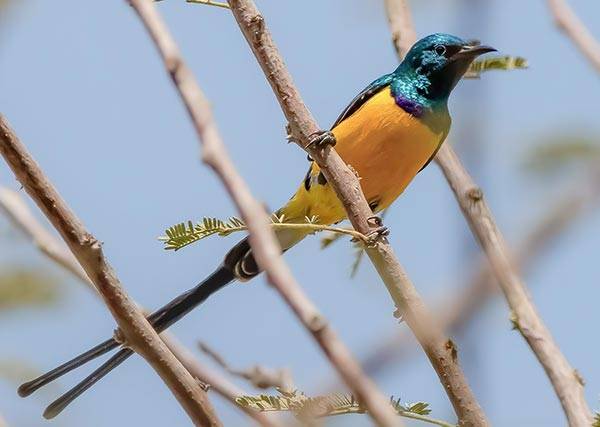Afghanistan – Armenia – Azerbaijan – Bahrain – Cyprus – Egypt – Georgia – Iran – Iraq – Israel – Jordan – Kazakhstan – Kuwait – Kyrgyzstan – Lebanon – Oman – Qatar – Saudi Arabia – South West Russia – Syria – Tajikistan – Türkiye – Turkmenistan – United Arab Emirates – Uzbekistan – Yemen

Capital: Cairo
Area: 1,001,450 km2
BirdLife International partner: Nature Conservation Egypt (NCE)
Total number of bird species: 453
Globally threatened bird species: 14
Country endemics: 0
Important bird and biodiversity areas: 34 IBAs with a total area of 34,720 km2
Rare birds committee: Egyptian Ornithological Rarities Committee
Specialities:
Red Sea seabirds, a wide variety of desert species, impressive numbers of wintering waterbirds, spectacular migration of soaring birds. Species composition has a strong African influence.
Ornithological interest:
Although Egypt is mostly hyperarid desert, the country is bisected by the Nile Valley and bordered by the Red Sea to the east, and these act as biological corridors, linking the Palearctic and Afrotropical ecozones. Thus, Egypt is an important bottleneck for migratory birds and, lying at the meeting point of these biogeographic realms, it also offers opportunities to see many African species that occur at the edge of their ranges and that cannot be seen elsewhere in the Western Palearctic region.
Breeding seabirds and waterbirds around the Red Sea include regional specialties such as White-eyed Gull, Sooty Gull, Brown Booby, Red-billed Tropicbird, Bridled Tern, Greater Crested Tern, White-cheeked Tern, Crab-plover and Goliath Heron. These species can be seen along the shore and islands near Hurghada and further south near Hamata and Wadi El Gemal. The best time of year to see most marine species is during the summer months when they are breeding. The mangroves of the Red Sea also host a range of interesting species including the localised alulensis race of Eastern Olivaceous Warbler and a recently discovered breeding population of Yellow Bitterns at Wadi Lahami. Wadi El Gemal National Park is a good area for the birdwatcher to seek out species typical of the Eastern Desert and holds Lichtenstein’s Sandgrouse, Desert Owl, Sand Partridge, Hooded Wheatear and occasionally even Verreaux’s Eagle. The town of Shalatine, near the Sudanese border, provides an opportunity to see Lappet-faced Vultures at close quarters, along with other birds of interest like Black-crowned Sparrow-Larks. The perimeter of the Gulf of Suez has several globally-important bottlenecks for migratory soaring birds, while South Sinai offers several specialties of its own, including Sinai Rosefinch and Tristram’s Starling, both of which can be seen around St Catherine’s Monastery. In autumn, the Mediterranean coast is good for migrants on their southward journeys as they arrive from across the sea, but it also experiences unfortunate bird hunting practices.
The Nile Valley hosts several African birds such as Senegal Coucal, Senegal Thick-knee and Nile Valley Sunbird. Other species of interest for Western Palearctic birders include Greater Painted Snipe, African Swamphen, Egyptian Goose and Striated Heron, while several endemic subspecies can be found here, most notably the Egyptian savignii race of Eurasian Barn Swallow. The region around Lake Nasser is also of note as it is often frequented by birds that are more usually found further south such as Three-banded Plover, African Collared Dove, Yellow-billed Stork and Pink-backed Pelican. Recent surveys have shown a marked increase in heron, egret and ibis breeding colonies around the lake’s shores and the area is an important wintering ground for Eurasian waterbirds.
Best times to visit:
Visits should be planned according to target species – March to May for spring migrants, July to August for Red Sea breeding seabirds, and late August for the dramatic migration of White Storks through South Sinai and the Red Sea. September to November is the key period for general autumn migration and is also the breeding season for Sooty Falcons. December to January is best for winter visitors and waterbirds along the Nile Valley.
Essential reading:
Goodman S & Meininger P (1989) The Birds of Egypt, Oxford University Press.
Svensson L, Mullarney K, Zetterström D, Grant P (2010) Collins Bird Guide, HarperCollins, UK.
Porter R & Aspinall S (2010) Birds of the Middle East, Christopher Helm.
(While the area covered by this book does not specifically include Egypt, it is nevertheless an essential and relevant reference.)
بورتر، ر.، أسبينال، س.، 2016. طيور الشرق الأوسط. ترجمة عبد الرحمن السرحان وتدقيق لغوي وعلمي: نابغ غزال أسود. اصدار البيردلايف انترناشيونال وجمعية علم الطيور بالشرق الأوسط والقوقاز. عمان، الأردن.
The above two references in Arabic are the Arabic smartphone app version of Birds of the Middle East (Porter & Aspinall) and the Arabic book version of Birds of the Middle East (Porter & Aspinall).
Trip report links:
January 2002 – Egypt and Jordan
3-10 April 2010 – Gebel Elba ornithological survey
3-10 June 2010 – Marsa Alam and southern coast
27 September-6 October 2011 – southern coast
19-26 November 2012 – Sharm el Sheikh
Compilers:
Sherif Baha El Din
